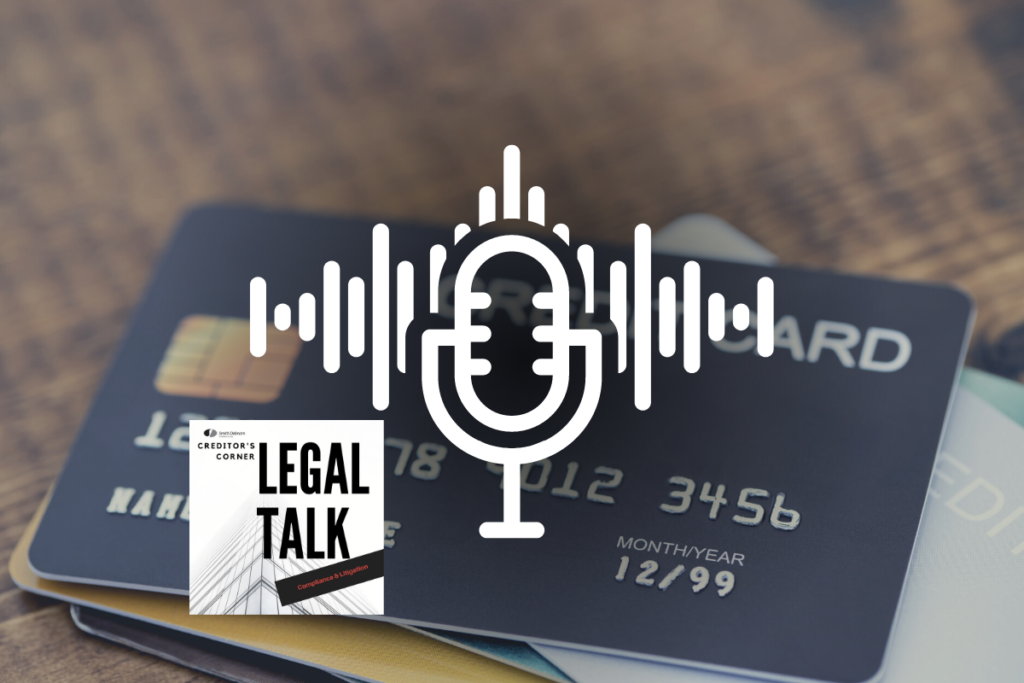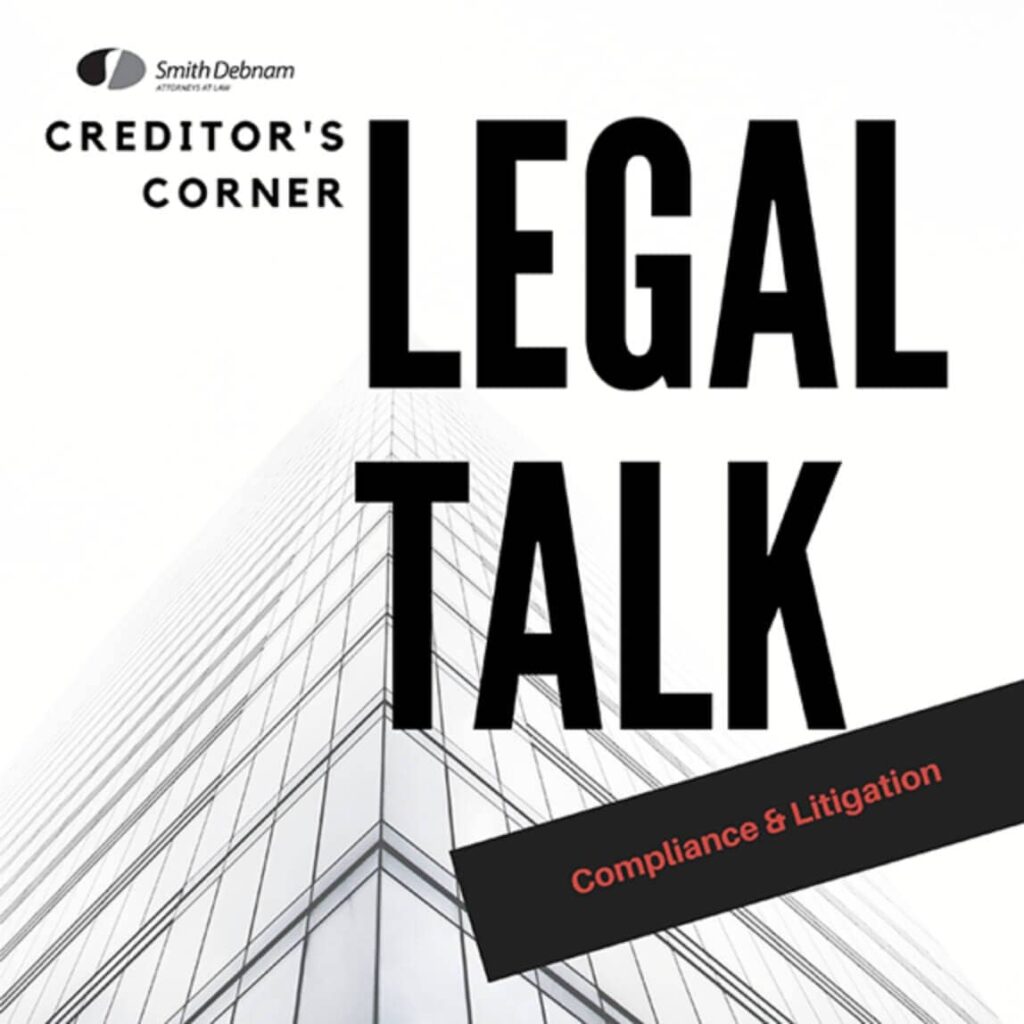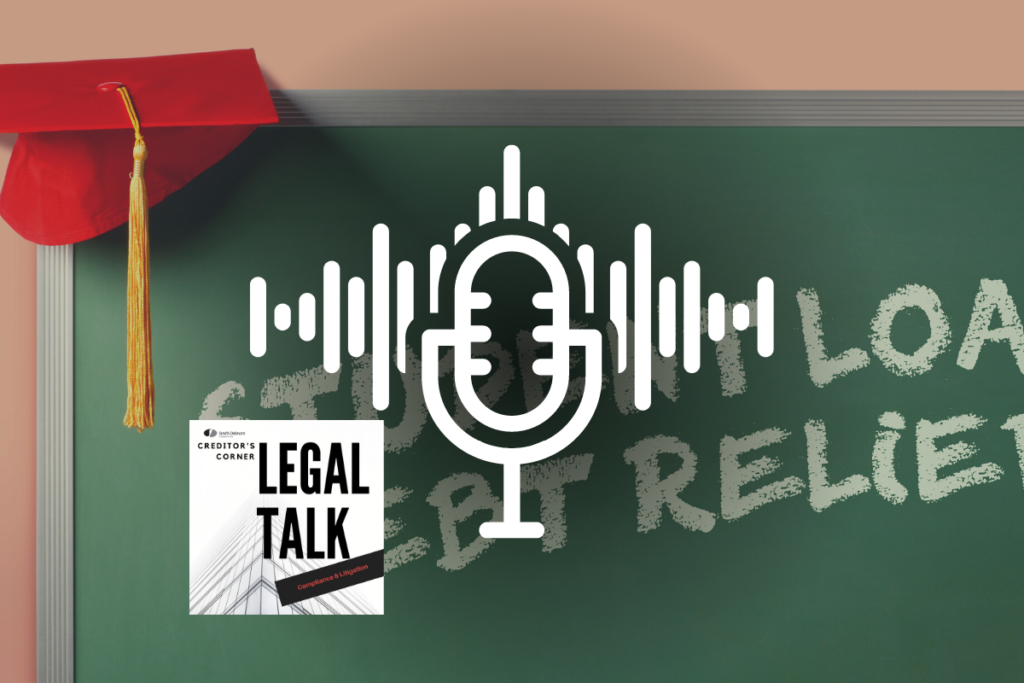[00:00] Christina McAlpin Taylor: Hello and welcome to the podcast series Creditors Corner Legal Talk, presented by Smith Debnam attorneys at Law, where we explore a range of legal topics impacting businesses and private individuals. So be sure to hit subscription so you never miss an episode. My name is Christina McAlpin Taylor and I’m an attorney in the firm’s creditors rights section. I’ll be your moderator today. Today’s topic is five things you need to know about itemization of debt for credit card accounts. This topic, although the title is long, is one of great importance to many of you who do creditors rights work. Before we begin, though, I want to note the information provided in this podcast does not and is not intended to constitute legal advice. Instead, any and all information shared is for general informational purposes only. Listeners should contact their attorney to obtain advice with respect to any particular legal matter. With that of the way, let’s turn our attention to this week’s topic. With us today is Melissa Tulis, and she is also an attorney in the creditors’ rights section of the firm.
[00:59] Melissa Tulis Smith: Hey, Christina, happy to be here.
[01:02] Christina McAlpin Taylor: We’re excited to talk to you guys about the five things you need to know about itemization of the debt for credit card accounts. Lisa, if you don’t mind sharing with the group what initially made you write this article and think about doing this podcast.
[01:15] Melissa Tulis Smith: Absolutely. There are so many rules and laws in the banking and financial services industry concerning itemizations and what type of disclosures banks, creditors, and financial service providers must disclose to their credit card consumers. We deal with that a lot here at Smith’s Debnam because the majority of our clients in our practice area are bank creditors and financial service providers from a banking standpoint. So from the standpoint of many of our clients, it’s important to understand not only what the bank is required to provide to its consumers, but also what a third-party debt collector or debt buyer will be required to provide.
[01:58] Christina McAlpin Taylor: I’m sorry, Melissa, I was just going to say, I’m guessing with the new regulation coming into effect, that was a big part of you wanting to research this again, is that right?
[02:05] Melissa Tulis Smith: Absolutely. So the new regulation that’s gone into effect this year has altered what banks and financial service providers and creditors do have to provide so far as itemization and disclosures to consumers.
[02:19] Christina McAlpin Taylor: Yeah, and I think probably you’re a lot like me. I’m really thankful for that new regulation app coming out and giving us some guidance on exactly what at least the Reg F considers to be itemization. Is that proven to be true for you, too?
[02:31] Melissa Tulis Smith: Absolutely.
[02:32] Christina McAlpin Taylor: And I know we’re going to get to this one a little while, but for everyone who practices in North Carolina to remember that there’s Reg F and then there’s the North Carolina debt buyer statute. Are those a little bit different?
[02:42] Melissa Tulis Smith: They are. And we’re going to really parse that out in this podcast because, unfortunately, they do require different types of itemizations and disclosures, which may prove to be a little confusing to the consumer. So we’re going to talk about that a little bit more in-depth as we get going.
[03:00] Christina McAlpin Taylor: Yeah, before we get too far along, I just want to let everybody know what the five main questions are that we’re going to talk about. We’re first going to talk about what type of itemization our card providers require to disclose to the consumer periodically. And that was a pretty simple answer that Melissa will get to us in a few minutes. Then we’ll move on to talk about how much transaction history is a card provider required to retain its records. How long do they actually have to keep track of this? As you can imagine, there’s quite a bit of documentation that comes along with the transaction history. Melissa will touch on that as well. And then we’re going to move on and talk a little more about what type of itemization are debt buyers required to disclose to the consumers. I mentioned a few minutes ago that in North Carolina we have a debt buyer statute. So it’s important that if you represent debt buyers or if you are a debt buyer, that you pay attention to the North Carolina statute related to debt buyers because that is different than the regass. And we’ll get to that in a minute. We’re also going to talk about what type of itemization our debt collectors required to disclose to the consumers. And I personally think that’s the most important part for myself. Like I said, I work in the Creditors Rights Practice Group, and when we are filing lawsuits or filing motions, it’s important that we are familiar with itemization that’s required of us. And finally, we’ll discuss a little bit about can more than one type of itemization be required? We hope to touch on these five questions, and we hope after we’re done with this podcast, you’ll have a better understanding of what itemization is and how it’s defined by reg F, and also how it’s defined by the North Carolina debt buyer statute. Does that sound good to you, Melissa?
[04:32] Melissa Tulis Smith: That sounds great. Let’s get going.
[04:35] Christina McAlpin Taylor: All right, so starting on the first one, Melissa, if you could tell us a little bit about what type of itemization the card providers are required to disclose to consumers. Tell us a little bit about that.
[04:44] Melissa Tulis Smith: So under the Federal Truth in Lending Act passed by Congress in 1968, you’ll often see that abbreviated in blogs and whatnot and whatnot as Tila T-I-L-A. Under that act, fees, interest transactions, and cash advances from the prior billing cycle must be separately itemized on a consumer’s monthly statement. However, that does not mean that the creditor must disclose or even keep track of the aggregate fees, interest transactions, and cash advances that are incurred during the life of the account.
[05:26] Christina McAlpin Taylor: The reason I want to stop you there just for a second, I’m sorry. Unless I want to ask you a little bit about that, and I’m sure you’re about to get to that, but tell us a little bit more about how that works when you have an open ended, revolving credit account. I know some people might be scratching their heads right now wondering, wait a minute, how could I do that? Or how do I do that? Can you explain a little bit more about that?
[05:45] Melissa Tulis Smith: Great question. The reason that it doesn’t make sense for a creditor to keep track of aggregate fees and interest and transactions is because open ended revolving credit accounts, most common example, this is a consumer credit card. With those accounts, the unpaid balance rolls over each month, so each billing cycle. And when that unpaid balance rolls over, which consists of fees, interest, and transactions from the prior billing cycle, it forms the new principal balance for the subsequent month. And that new principal balance is what interest is calculated on for the next billing cycle.
[06:30] Christina McAlpin Taylor: Thank you so much for clarifying that, Melissa. I was sitting there thinking that that was an important point that we point out to everybody. Most of us are familiar with that. But again, to clarify what Melissa is saying, if you’re dealing with, for example, a credit card account, like she said, these open ended revolving credit card accounts, that UNPay balance rolls over, and that’s a good way to think about it. So thank you for answering our first question related to the type of itemization that card providers are required to disclose to consumers. I think most of us are pretty familiar with that. That’s been around for a long time. So let’s move on to some of the newer stuff, such as how much transaction history is a card provider required to retain its records? I talked about this in the beginning. Most of us who do creditors work, or even us as consumers know that we get these statements monthly. So if you’ve had an account with somebody for ten or 15 years, it can be anywhere from 500 to 800 pages. I just had a paralegal come in my office earlier this morning and show me a motion for summary judgment that she needs to mail out. And there were 720 pages of statement of accounts. And she was like, do you need to see that? I was like, I can look at the soft copy electronic version. Thank you for not printing an extra copy, although we’ll have to, of course, North Carolina provide that for a summary judgment motion. So tell us a little bit about how much transaction history a card provider is required to retain. And then the second part of that question would be for how long do they have to retain it?
[07:50] Melissa Tulis Smith: Definitely. So first off, that transaction history, what it’s going to consist of are those monthly statements we discussed earlier. Those monthly statements are the piece of paper or pieces of paper that you receive if you have a credit card on a monthly basis, either by email or by good old fashioned snail mail that’ll show all of the finance charges, purchases, cash advances, and credits from your prior billing cycle. And so the transaction history is made up of the statements that have been sent for that account for the life of that account. However, as we all know, you may have a credit card for several years, you may have a credit card for decades, and that would not be an abnormal thing. And for that reason, under federal law, creditors are only required to maintain these monthly statements for two years. That doesn’t mean that some creditors won’t keep the statements for a longer period of time, but they’re only required to keep them for two years. Now, this comes up often in our practice area of consumer collections because we deal with a lot of charged off credit card accounts. Now, those charged off credit card accounts, the two year period of statements that we have access to may include the six months prior charge off where there is little to no activity on the account. There may be no payments or purchases made on the account for that several month period before charge off. But again, it’s important to keep in mind how much of a mammoth task it would be to require creditors to keep these records indefinitely. I know some people who have got a credit card out when they were in college, and they keep it for 30 years, and that credit card was what they used to buy their morning cup of coffee for 30 years. So that’s just a mammoth amount of information. And for that reason, there’s no requirement that creditors maintain these records forever. Absolutely.
[10:00] Christina McAlpin Taylor: Melissa. I think that’s a really valid point. I’m an example of that exact person. I have had one credit card since I was in high school, my senior year, since 1999. So that’s 20 plus years of statements that have been sent to me previously by mail. But now I get them mostly electronically. So that makes sense that the creditors are not required to keep those forever in my practice. And I’m sure you would agree with this as well. Most of my clients do retain their records for more than two years, but it’s nice to know that’s the minimum amount that they need to do. Do you find that to be common in your practice as well?
[10:33] Melissa Tulis Smith: I do, definitely. It’s different for every creditor, but most creditors do retain a little bit more than they’re absolutely required to retain.
[10:45] Christina McAlpin Taylor: That’s the experience I’ve seen. All right, well, moving on to what I think will be another important question is what type of itemization are debt collectors required to disclose to the consumers? What is it that we actually have to do and actually have to provide to the consumers. Can you tell us a little more about that?
[11:02] Melissa Tulis Smith: Great question. And this brings us to that new law that we were talking about earlier, rather the new rule that we’re all required to adhere to. So, the Consumer Financial Protection Bureau, commonly known as the CFPB, recently released its rule on debt collection practices. This is commonly called the debt collection rule. Now, the debt collection rule interprets the Fair Debt Collection Practices Act, and like we said, it takes effect this year. The new Debt Collection Rule requires debt collectors to identify an itemization date and then itemize any fees, charges, and payments received after that date. The debt collection can you tell us.
[11:50] Christina McAlpin Taylor: I’m sorry to interrupt, but I was just curious about this. I have been reading up on this rule for a while and I was excited to hear is it true that there are five different dates that they can choose when they’re determining what date they’ll use for the itemization?
[12:04] Melissa Tulis Smith: That is correct. For better or for worse, the creditor has five different points in the life of the account that it can choose that itemization date. Those five different options that the creditor has. Those five different dates are the last monthly statement date, the charge off date, the last payment date, the transaction date, or the judgment date. If we’re talking about a post judgment credit card account and for the credit.
[12:34] Christina McAlpin Taylor: Card accounts, that’s important to me because I do a lot of work for creditors who are credit card accounts. What are you seeing most of your clients or some of your clients using as the itemization date? Which date are they picking? Or are you seeing something that’s common or is it kind of all over the board?
[12:52] Melissa Tulis Smith: In my experience, credit card creditors are almost exclusively using that charge off date. It seems to be the date that makes the most sense in the life of the account to use as the itemization date. Another date that might work for credit card companies would be the last payment date, but the charge off date nine times out of ten is what you see.
[13:15] Christina McAlpin Taylor: Okay, and what about for like, an auto deficiency accounts? Are you seeing any common threads there?
[13:21] Melissa Tulis Smith: With auto deficiency accounts, we’re also seeing the charge off date being the favorite date. However, with auto deficiency accounts, there are a bit more options that could make sense for that type of line of credit. For example, the transaction dates could make sense when we’re talking about an auto loan where there was a singular transaction supposed to, where with a credit card account, the transaction date really wouldn’t make sense because we’re talking about revolving credit and could be several hundreds or thousands of transactions over the life of the account.
[13:54] Christina McAlpin Taylor: Okay, so very good. So the five different dates that you mentioned were the charge off date, the last payment date, the transaction date, the judgment date, and I forgot one. Was it the last monthly statement date?
[14:08] Melissa Tulis Smith: Last monthly statement date.
[14:10] Christina McAlpin Taylor: Okay, very good. Well, thank you for answering that. Did you have something more to add?
[14:15] Melissa Tulis Smith: Yes. Briefly, this itemization requirement is forward looking, and what I mean by that is it’s only requiring us to itemize everything after that itemization date. So it does not require a creditor to itemize fees, charges, and transactions which occur prior to the itemization date. And that’s probably why we’re seeing the charge off date being favored, because the majority of transactions, fees and charges that a bank or creditor is going to need to itemize the majority are going to take place before the charge off date. So it’s easier, it’s more efficient to use the charge off date. And that’s why we’re seeing that being the date that’s favored.
[15:02] Christina McAlpin Taylor: That makes good sense to me, what you’re saying. So for a credit card company, for example, if they choose the charge off date and don’t charge any additional fees, it may just be that they itemize the principal amount, and that’s all that they’re going to show in that. Is that a correct statement?
[15:16] Melissa Tulis Smith: Exactly. And if you’ve only got one amount on there, it’s even easier to itemize. Perfect.
[15:22] Christina McAlpin Taylor: Well, I appreciate that insight. That’s really helpful. So, like we said, there’s five dates that you can choose from, and we said them before. We’ll say them one last time. But there’s the last monthly statement date, the charge off date, which Melissa and I are finding to be the common date that a lot of our clients are using. There’s also the option for the last payment date, the transaction date, which, like Melissa said, could be helpful for an auto loan or something that maybe had only one transaction. And then the judgment date. We don’t typically find an instance where we’ll use the judgment date because typically when we are representing creditors, we are trying to obtain a judgment and haven’t yet got that judgment date. So that hasn’t been something we have seen used very often yet. But there may be a case where that would be helpful. So, moving on to the fourth question, what type of itemization are debt buyers required to disclose to consumers? And we mentioned this in the beginning, and we want to remind everybody again that in North Carolina, there is a specific debt buyer statute, so we have to pay particular attention to that. And I think Melissa is going to talk about that for a few minutes, and she’ll also mention a few cases that are at the court of appeals or that are coming up.
[16:28] Melissa Tulis Smith: Sure. So this is unfortunately where it starts to get complicated, Christina, because we are talking about the interplay between North Carolina state law and federal law, federal rules, rather. So, in 2009, the North Carolina legislature amended the North Carolina collection agency act to provide new and frankly, in my opinion, quite onerous requirements for debt buyers specifically with regard to itemization. In order for a debt buyer to obtain judgment in North Carolina, that debt buyer must provide an itemization of charges and fees claimed to be owed and an itemization of post charge off additions where that applies. Now, keep in mind, these laws are still relatively new to our state. 2009 was not that long ago, and we have not had that many opportunities for the Court of Appeals in the Supreme Court to interpret this act. So courts are still wrestling to figure out what some of these statutory provisions mean. A recent case law interpreting these statutes has frankly muddied the waters regarding additional itemization requirements that are imposed on debt buyers seeking to collect debt from North Carolina consumers. Quite oddly. These new requirements require debt buyers suing for delinquent debt to disclose even more information than the original creditors that they purchased the debt from. In fact, debt buyers are required to disclose to consumers more information than original creditors are even required to retain in their records. The most recent case law that we’ve seen on this matter is in a Court of Appeals decision published on December 31 of 2020 towns versus Portfolio Recovery Associates. In that Court of Appeals case, they found that a debt buyer, in order to obtain a judgment against a debtor for a charged off balance, must itemize the total creditor assessed charges and total creditor assessed fees that contributed to that charged off balance. So here you may notice we’re talking about something very different from what we talked about earlier with the itemization date under the debt collection rule. The itemization date under the debt collection rule, we said you need to pick a date, probably the charge off date, and you need to worry about everything that happens to that balance after that itemization date. Here we’re talking about everything that happened before that itemization date. So this is a backward looking itemization requirement. It’s a little confusing, kind of balancing those two out. A petition for discretionary review is pending with the North Carolina Supreme Court, which may alter this ruling. But for now, all those listening should assume that the Town’s case from the Court of Appeals is controlling. Keep in mind, this makes a debt buyer’s job exceptionally difficult when a selling creditor does not provide all of this information or may not even have all of this information at the closing. The Town’s case also puts new pressure on original creditors as well to retain this itemization if they ever want to be able to market this debt. So that’s important to keep in mind, even if you aren’t a debt buyer, you’re not representing a debt buyer, even if you are an original creditor. You may want to think about what debt buyers are required to provide if you ever want to sell your charged off debt to a third party.
[20:25] Christina McAlpin Taylor: Melissa, I think you make some really good points in there, and I would encourage everybody who’s listening. If you have questions about that, you can, of course, reach back out to us. But you’ll need to make sure you’re familiar with that North Carolina debt buyer statute and then also familiar with Regulation F, which is what Melissa keeps referring to as the new debt buyer excuse me, the new debt collection rule. The new debt collection rule, in my opinion, is a lot easier to follow and pretty easy for our clients to comply with. We have now with this new town’s opinion in our office, had to go back through and make a few changes to make sure that we are also complying with the town’s opinion. And we’ve been able to do that, and you’ll be able to do that, too, but it just does take some time to work through and look through your procedures. And like Melissa suggests that this really does affect everybody because these original creditors, we do put a lot more pressure on them when they’re selling the debt, or we put pressure on our clients if they’re debt buyers to make sure they can seek that information from the original creditor. I had a client approach us recently asking us if we could take new placements for debt buyer work. And the first thing I said to them was, I’ll need to see what type of documentation you have so I can make sure that we can comply with the North Carolina debt buyer statute. And like Melissa keeps referring to the new debt collection rule, fortunately, this client did have the proper documentation and has a really good relationship with that original creditor, so it can get us whatever we need. Those are the type of questions that you should be asking yourself if you’re going to onboard a new client, a debt buyer client in North Carolina. It’s really important that you’re familiar with that statute as well. So thank you for that information, Melissa. To sum it up, I have one last question, which is can more than one type of itemization be required? And you’ve pretty much touched on this answer already, but if you would summarize that for us one more time.
[22:03] Melissa Tulis Smith: Yes. So the answer to this is yes. Sometimes more than one type of itemization can be required. And this poses an issue because it’s frankly kind of confusing to a consumer to have two different itemizations provided to them that look probably completely different. The reason that more than one type of itemization may be required is because under the new federal debt collection rule, debt buyers are also acting as debt collectors. So our North Carolina debt buyers are going to be subject to the debt buyer statute. That’s state law. But they’re also going to be subject to the federal debt collection rule. So because they’re subject to both of these pieces of legislation, they’re going to be required to produce one itemization under the federal rules. And like we said, that’s going to be forward looking from that itemization date and then they’re going to have to provide a second itemization under North Carolina law. Like we said, that’s going to be backward looking. So these are going to look very different and definitely pose the potential for confusion to the average consumer. Frankly, they could pose the potential for confusion to the average attorney.
[23:21] Christina McAlpin Taylor: That’s right. The good news is, so far, at least in our practice, we haven’t had too many issues with this. Like I said before, we’ve come up with some good procedures to make sure that our debt buyer clients are able to comply with the North Carolina debt buyer statute and like I said, complying with this new regulation. F really hasn’t been as challenging as we initially thought it was. A quick follow up question to that. Melissa, have you found that most of your clients are letting you guys take the data and do the itemization yourself or some of the clients providing that itemization for you? Is it kind of a mixed bag? Do you have any insight on that?
[23:54] Melissa Tulis Smith: Great question. So for the itemization that’s required under the debt buyer statute of North Carolina, our clients provide that themselves. That’s a little bit more comprehensive. You have to look a lot further into the life of the account so they handle that. However, for the itemization that forward looking itemization from most frequently the charge off date, that’s required by the federal debt collection rule that we can handle in house. It’s a much simpler itemization to find. Like you said earlier, if the creditor has not charged the interest or fees since charge off, then that entire itemization is just going to be that charge off amount and nothing else has been added or detracted since that date. So that’s a fairly simple itemization that we’re more comfortable doing here at our firm.
[24:46] Christina McAlpin Taylor: Yeah, absolutely. I agree with what Melissa said. We have some clients actually who are starting to give us new data points that they call the itemization data points, which makes it really easy. We’re able to pull that from our computer program, so that’s been helpful as well. So I think that we have come a long way from when this rule first came out and we were first reviewing it and nervous about itemization. I think everybody has got a better grasp on that and I’m hopeful after listening to these questions and answers that everybody listening today also is comfortable with that. Do you have anything else, Melissa, that you want to add? Before I conclude this podcast, I would.
[25:22] Melissa Tulis Smith: Just sum it up by saying that knowing what information and documentation that you or your client will need to provide when forwarding an account to a third party, to collect or to sell a charge off account to a debt buyer is really key to loss mitigation, even for clients that are not debt buyers.
[25:45] Christina McAlpin Taylor: That’s right. I think we could have a whole other podcast talking about when you’re onboarding client, what type of information you should look for. But with this new regulation F, it is important that you make sure you have the data you need for the itemization. That’s always important. So I think that is a good way to conclude this. I thank everybody for listening today. Melissa. Thank you for your great answers to my questions. I do invite any of the listeners today who are listening and do have questions for Melissa and I. You’re welcome to reach out to us by email or you can even find our direct dial. If you go to Smith Debbie’s website, you can find it under our name. It has both of our email address and our phone numbers. And feel free to check out some other episodes that we have. There’s lots of really good related topics, so I remind everybody to subscribe to our podcast, Creditors Corner Legal Talk, and I hope that everybody stays well and has a good rest of your week. Thanks again, Melissa.
[26:38] Melissa Tulis Smith: Thank you.







